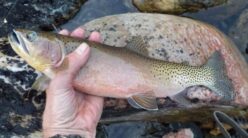When I started hunting in the 1950s, many of the people we hunted with were my dad’s age or friends of my uncles. Since they were born back in the 1920s or earlier, they often hunted with rifles and calibers that most of today’s hunters younger than 55 years old may never have heard of or seen.
The reasons they aren’t used much anymore are because ammunition-makers stopped making ammunition for them, they were considered obsolete as newer calibers were developed, they were never converted from black powder to smokeless powder cartridges, or their ballistic characteristics were similar to more popular cartridges, and newer, more powerful cartridges along with rifles to fire them were developed.
Still, I see some of these old timers from time to time lurking in someone’s gun case, or at the range, hanging on a wall for show, or in Cabela’s stores where collectors can purchase them.
The last time I checked, Olin Corporation was making limited numbers of several lever action rifles such as the Model 76, and calibers that were originally developed in 1876 or a little after for collectors.
Once the Winchester Model 94 was developed it became the platform for many early calibers that were popular with American hunters.
I thought it might be fun to do a little research and write about several rifles and calibers that I am somewhat familiar with, but never owned with the exception of one.
The .25-35 WCF was introduced by Winchester in 1895 in the model 94, and was probably the first cartridge we would call a “small bore,” to be loaded with smokeless powder in the United States. It was originally a smokeless powder round, as was the .30-30 in spite of the black powder connotations of the hyphenated names.
Both Savage and Marlin used the .25-35 WCF in lever action rifles along with Winchester. Since the 1940s the .25-35 WCF has been missing from the list of factory chamberings in this country. I don’t believe I have seen one in the field since I was in my twenties. However, reloaders can still load for it.
The standard factory load for the .25-35 WCF was a 117 grain jacketed bullet pushed along at 2230 feet per second (fps). That gives it less than 1000 foot pounds(ft. lbs.) of energy at 100 yards.
The .30-40 Krag is one of the more significant cartridges in United States history, and was given to me by my grandfather on my mother’s side when I was about 12 years old. It was the first smokeless powder “small bore” cartridge to be adopted by the U.S. Army when it replaced the .45-70 Government in 1892. It was originally developed for the Krag- Jorgensen bolt action rifle and was carried by U.S. Troops at the battle of San Juan Hill in Cuba.
Thousands of Krags were sold to the public and used to hunt deer, elk, moose and bear. It’s ballistics were roughly similar to a .308 Winchester, but it was loaded with a 220 grain jacketed bullet that provided reasonably deep penetration on most large game.
Unfortunately, I sold mine because I thought it was too long and heavy to carry around the mountains. Now I wish I still had it.
I have written before about the British Lee Enfield .303 which was adopted in 1888 and is still not only popular with many American hunters, but is the current issue rifle of the Arctic Rangers, an Inuit unit that patrols Canada’s vast Artic region and who have an extraordinary ability to detect threats on snow, ice and in bad weather. Most of the members of the Arctic Rangers are decedents of previous Members of the unit and the Lee Enfield .303 rifles have been handed down from father to son.
The Lee Enfield .303 was a bolt action, black powder cartridge converted to cordite in 1892. It has seen duty all over the world in places like Africa, India, Australia, and Canada.
Oddly, The Lee Enfield gained favor in Africa as a big game hunting rifle, even for the largest and most dangerous game.
Today, a 215 grain bullet is pushed out the muzzle of the Lee Enfield .303 using smokeless powder, at 2180 feet per second. Only a 180 grain soft nose is loaded commercially in this country and it is listed at 2460 feet per second.
The .32 Winchester Special, a black powder cartridge which was introduced in 1903 and is exactly as powerful as the .30-30 WCF, no more so and no less so. The .32 Winchester Special will do whatever the .30-30 will do in the same rifles and at the same distances. A 170 grain bullet exits a Model 94 barrel at 2230 feet per second. The .30-30 drives the same bullet out of the model 94 barrel at 2200 feet per second.
The reason the .32 Winchester Special was developed was supposedly because many felt that smokeless powder would never replace black powder in modern firearms. Of all the strange, cockamamie reasons for a caliber’s existence, the 32 Winchester Special has to be the strangest.
The oldest cartridge on this short list is the 38-55 WCF which was developed in 1884 as a black powder cartridge and was one of the original chamberings of the Model 94 lever action. I’m assuming it was changed to a smokeless powder round when it was chambered in the 1894 lever action rifle. It was a little better deer rifle than the .30-30, at least with hand loads. It was originally developed as a Ballard target cartridge and was used in many of the fine match grade single shot rifles of the day.
The 38-55 used a 255 grain bullet that had a muzzle velocity of 1285 feet per second. Various higher velocity factory loadings were offered at different times, one with the same bullet at 1550 feet per second.
The factory loading was dropped in 1970 and resumed in 1983.
The 38-55 WCF was a very accurate cartridge that was popular for quite a long time.
Smokey Merkley was raised in Idaho and has been hunting since he was 10 years old. He was a member of the faculty of Texas A&M University for 25 years. There he taught orienteering, marksmanship, self-defense, fencing, scuba diving and boxing. He was among the first DPS-certified Texas Concealed Handgun Instructors. He can be contacted at mokeydo41245@hotmail.com.



